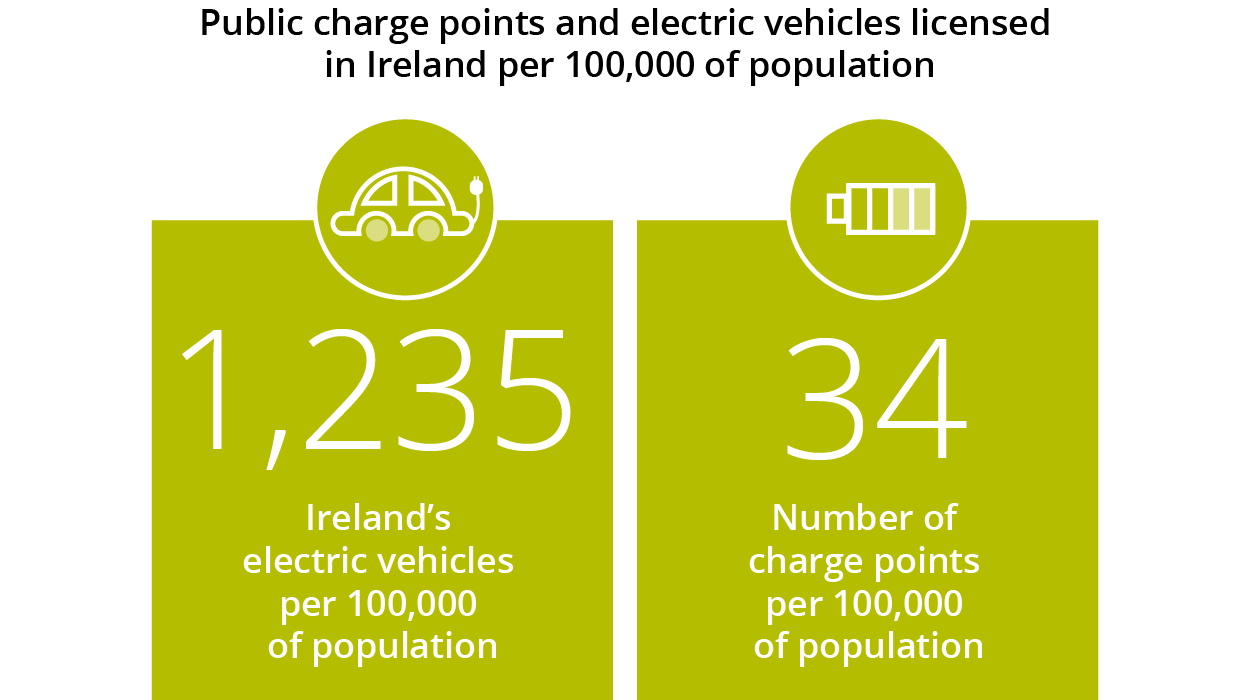
EV Charging Infrastructure: Legal aspects in Ireland as the 60km interval gets closer
In Ireland, electrification of vehicle transport will depend on access to adequate public charging infrastructure. As new EU law nears completion and Ireland publishes the Climate Action Plan 2023 and an EV Charging Infrastructure Strategy, we review latest legal developments and considerations relevant to delivery.
Drivers of change
EU Fit for 55 legislation is nearly finalised and it aims to achieve very significant emissions reductions by 2030.
The Commission states that around 25% of EU emissions come from transport and calls for a 90% reduction compared to 1990. Several mechanisms are intended to achieve this.
Alternative Fuels Infrastructure Regulation (“AFIR”)
The proposal for a new Regulation (and repeal of the Directive) would require rollout of recharging infrastructure for light- and heavy-duty vehicles along the Core Network and Comprehensive Networks, shown here:

Image credit: https://transport.ec.europa.eu/
It sets minimum levels of recharging pools, summarised in the table below.
MEPs would like to go further and faster. Their amendments are here. For example, they would bring Comprehensive Network requirements forward and increase the available electricity volumes.
The Council position is also available here and negotiations on the final position are underway.
| All figures subject to negotiation | Core Network | Comprehensive Network |
| By end of 2025 | Light-duty vehicles: Every 60 km (300 kW including a station with an output of 150 kW).Heavy-duty vehicles: Every 60 km (1400 kW including a station with an output of 350 kW). | |
| By end of 2030 | Light-duty vehicles: Every 60 km (600 kW including two stations with an output of 150 kW).Heavy-duty vehicles: Every 60 km (3500 kW including two stations with an output of 350 kW). | Light-duty vehicles: Every 60 km (300 kW including a station with an output of 150 kW).Heavy-duty vehicles: Every 100 km (1400 kW including a station with an output of 350 kW). |
| By end of 2035 | Light-duty vehicles: Every 60 km (600 kW including two stations with an output of 150 kW).Heavy-duty vehicles: Every 100 km (3500 kW including two stations with an output of 350 kW). |
AFIR provides for an iterative process between Member States and the Commission to develop planning to deploy the required infrastructure, and this is reflected in Ireland’s EV Charging Infrastructure Strategy.
TEN-T Regulation
Charging infrastructure will also be addressed in a revised TEN-T Regulation. This Regulation identifies the Comprehensive, Core, and Extended Core Networks, as well as the Projects of Common Interest and the requirements they need to meet to obtain the benefits that PCI status confers.
Renewable Electricity Directive
The draft for a revised Renewable Energy Directive requires that economic operators supplying renewable electricity to EVs through public recharging stations receive credits capable of being sold to fuel suppliers subject to a renewable obligation.
It requires that non-publicly accessible recharging points can support smart charging and, where appropriate, bidirectional charging, and that vehicles can meet the data requirements needed for integration in the electricity system.
It expresses renewable targets in transport in terms of ‘greenhouse gas intensity’, which supports electrification as the most efficient way to decarbonise road transport, as compared to renewable fuels and recycled fossil fuels.
Buildings
The proposal to revise the Energy Performance of Buildings Directive will build on existing requirements for recharging infrastructure in private buildings, homes and workplaces, as well as in relation to smart and bi-directional charging.
Emissions
A new EU emissions trading scheme for fuel supplied to transport, to begin in 2027, will require fuel suppliers to pay the cost of carbon for fossil fuels.
Proposals to revise the Effort Sharing Regulation and Energy Efficiency Directive will increase Ireland’s obligation to reduce its emissions and to improve efficiency, as well as the role required to be played by transport.
Developments in Ireland
In Ireland, decarbonisation targets are enshrined in law. Sectoral emissions ceilings require a reduction in transport emissions by 50% in 2030 compared to 2018.
Targets to be met in 2030 are reflected in the Climate Action Plan 2023, an annual roadmap with statutory footing. 2030 targets are: all new car registrations should be EVs, there should be nearly 1 million EVs on roads, and EVs should account for 30% of cars.
A number of actions are to be taken in 2023 by the Zero Emission Vehicles Ireland Office (“ZEVI”), including undertaking planning and enabling works for the AFIR requirements, and advancing destination and residential (neighbourhood) charge point schemes. There is a commitment to roll out the motorway high-powered charging network in 2024.
In January 2023, ZEVI published the new EV Charging Infrastructure Strategy 2022-2025 and Implementation Plan, available from this page. These looks a home, residential neighbourhood, destination and en-route charging, but highlight the need to progress publicly accessible infrastructure highlighted, for example, by the following statistic:

Content above sourced from: www.gov.ie
The strategy commits to ensuring compliance with AFIR. It assumes approximately 169,000 kW of charging power will be required by 2025 and identifies scenarios for delivery.
The Implementation Plan indicates that ZEVI will, in 2023, publish several delivery plans and roll out support schemes. Standards on accessibility and safety, displays, payment methods, price transparency, and comparable, reasonable and non-discriminatory pricing are to be reviewed or developed. As regards full AFIR implementation, a final National EV Policy Framework is to be in place by March 2025. A public-private infrastructure stakeholder group has been established.
Also relevant is the National Development Plan, which allocated €100 million up to 2025 in charging infrastructure, intended to leverage multiples in private financing, as well as the National Sustainable Mobility Policy. Other policies are the National Policy Framework on Alternative Fuels Infrastructure for Transport in Ireland (2017- 2030), the Road Haulage Strategy (2022-2031), and the National Energy and Climate Action Plan.
Key legal and commercial considerations
EV charging points can be rolled out in several ways including through collaboration between a state body and a private sector entity (by way of a concession contract or otherwise); procurement of charging infrastructure by landowners or commercial entities who sub-contract the operation of charging infrastructure; or private sector development of EV infrastructure.
In any scenario, there are a number of legal considerations for the developer, funder or charging unit operator (“Charge Point Operators” or “CPOs”). The following are illustrative examples of areas that are relevant.
1. Energy regulation
Alternative fuels infrastructure: At a macro level, the requirements of AFIR and the TEN-T Regulation will help drive the Government’s commitment to roll out adequate infrastructure. The current Directive (which is partially transposed in Irish law) sets out certain obligations for CPOs. They involve the provision of non-discriminatory and ad hoc access to charging infrastructure for users, information to be provided to users including as to charging point locations, and complaints’ services.
When the new AFIR comes into force it will be directly binding in Ireland without the need to be transposed in domestic law, though the Government may make regulations to provide for its implementation. The proposal includes obligations and entitlements for operators. For example, operators would have to ensure publicly accessible charging points are capable of smart recharging. Operators would be entitled to purchase electricity from any EU electricity supplier. In Ireland, this may first require completion of the Celtic Interconnector.
Grid upgrades and network development: As in many jurisdictions, there is no doubt that Ireland needs to invest in the grid, not only to support new decarbonised solutions like EVs, but also to connect the considerable volumes of new renewable generation under development to support this. The 2030 ambition is fairly staggering: 22-24GW more capacity by 2030, a five-fold increase in current renewable capacity.
Areas to watch are EirGrid’s ongoing revision of Shaping our Electricity Future, and how the Commission for the Regulation of Utilities & SEM Committee go about evolving market rules to facilitate bidirectional charging, smart metering and smart home charging, as well as incentives for flexibility or demand response. Entities considering onsite generation and/or storage – which is supported in several ways by Clean Energy Package legislation – should also factor in the potential for installation of charging facilities independent of the grid.
Licensing regime and consumer protection: Any entity that supplies electricity to end-users is required under the Electricity Regulation Act 1999 (the “1999 Act”) to hold an electricity supply licence. The Commission for the Regulation of Utilities published two decision papers on EV charging infrastructure, which take the approach that the infrastructure operator is the “end user” for the purposes of the 1999 Act, meaning that CPOs are unlikely to require a supply licence to operate, thus ensuring that third parties are free to offer and provide charging services. Relevant provisions in the 1999 Act have since been amended but, for various reasons, this is not a clear basis to assume an intention to change the regulatory position in this area.
CPOs are, however, required to enter into contracts with licensed electricity suppliers for the supply of electricity. Such operators can then offer access to their charging infrastructure on a commercial basis, though other third parties may also be involved, as we discuss below.
2. Planning permission
In order to roll out charging point infrastructure, entities may need to obtain planning permission for the installation of charging points on their land, although it is worth noting that under the Planning and Development Acts and Regulations, certain charge points are exempted from the obligation to obtain planning permission. Giving consideration to whether planning permission will be required for the installation of EV charging points is therefore likely to be important for developers.
Ireland’s planning regime is undergoing reform following a 15-month review, which culminated in the publication of a Planning and Development Bill. The intention is to modernise the planning system and ensure delivery of key infrastructure, and there is increased emphasis on strategic planning. The Government also recently reviewed planning guidelines for EV charging infrastructure and issued guidance to local authorities.
3. Financing
In terms of accessing funding, one approach is partnerships between the public and private sectors. There are a number of options available to infrastructure operators to fund the roll out of EV charging infrastructure in circumstances where the purchase and installation works require financing. The CPO will earn a revenue stream from consumers for use of the charging infrastructure. In purely private operations there will be demand risk associated with this revenue (i.e. the CPO’s income will depend on the demand uptake from final consumers) though it may be possible to mitigate this risk where the final users are vehicle fleet operators rather than private individuals who (particularly in urban areas) may be more likely to use home or neighbourhood charging infrastructure. If a public body appoints a concessionaire to operate charging points, there may be a fixed revenue stream paid to the operator. A hybrid of both of these models may also be employed.
EV charging infrastructure done on a larger scale basis may, therefore, be capable of being project financed (where security is taken over contracted revenue streams). On a traditional project financing, lenders would also take security over the actual physical assets as well, though this may be less relevant in the case of charging infrastructure, given that it is likely to be installed in multiple locations and, in some cases, on land owned by third parties (rather than on a single site). They also may, in some cases, be upgraded or replaced with newer technology over a period shorter than the tenor of a traditional project financing. Other financing options may be available depending on the specifics of the project: there have been examples of energy companies entering into green corporate loans in order to finance the development of charging infrastructure, given that infrastructure for clean energy vehicles is one of the categories of green projects listed in the LMA’s Green Loan Principles.
At EU level, the investment limb of the European Green Deal and the Sustainable Finance Package provides further options for funding EV charging infrastructure. Green bonds or subsidies may be available to fund green transport solutions (based on technical screening criteria).
4. Building regulations
Legislation provides for minimum standards for certain buildings. The European Union (Energy Performance of Buildings) Regulations 2021 apply to (a) new buildings, (b) existing buildings (other than dwellings), and (c) buildings undergoing major renovation. They require that:
- existing buildings, other than dwellings, with more than 20 parking spaces have one or more charging points by 2025,
- buildings, other than dwellings, (new or undergoing major renovation) with more than 10 parking spaces have at least one charging point for every five parking spaces, and
- buildings containing one or more dwellings (new or undergoing major renovation) with more than 10 parking spaces have ducting infrastructure (to allow for charging points) for each parking space.
Recent amendments to the Building Regulations 1997 to 2022 also require that ducting infrastructure is installed:
- in respect of multi-unit buildings that are new or undergoing major renovation (where the renovations concerned include the car park or electrical infrastructure of the car park), at each car parking space located inside or within the curtilage of the multi-unit building, and
- in respect of a new building that is a dwelling (other than a multi-unit building), where a parking space is located within the curtilage of the dwelling.
5. Property considerations
Existing commercial tenants wishing to install EV charging facilities on their premises will need to review the terms of their lease to confirm if there are any restrictions on the type of works they can carry out. For example, many commercial leases prohibit alterations to the building structure or, at the very least, require the landlord’s consent before any works can be done.
Those who arrange for the provision of services to tenants in multi-let buildings (such as property agents and managers) will need to review occupier contracts to confirm if the cost of installing EV charging facilities can be recouped via the service charge regime, whereby occupiers contribute a proportion of the cost of the services.
Where new leases or licences are granted specifically for the development or operation of EV charging facilities, parties will wish to ensure that the contract covers all relevant commercial and legal points, such as in relation to how the rent will be calculated and how the EV charging facilities will connect to the grid or any ESB substation on the land. Landowners and CPOs may wish to consider entering into agreements for lease or option agreements whereby the grant of the lease or licence is conditional on the granting of statutory consents.
6. Health and safety
CPOs will be required to comply with all applicable health and safety laws in Ireland, including the Safety, Health and Welfare at Work Act 2005 and the Safety, Health and Welfare at Work (Construction) Regulations 2013. Where the CPO is not also the site owner, the site owner may also be obliged to assess and manage the health and safety risks linked to charge point installation and use.
7. Commercial arrangements for consumer services
Charge point owners or CPOs may not necessarily contract with final customers. They may contract with mobility service providers and the final consumer offering may wrap several services such as priority charging access, parking space, or consolidated payment, billing and discounting arrangements. This could be provided via a third party platform.
It is important that the commercial arrangements are clear around which entities are responsible for complying with the legal requirements in the areas discussed above, as well as the wider mobility and consumer law elements relating to accessibility, data protection, information provision, and billing. Pass through of flexibility price signals and allocation of green benefits may also require consideration. Parties will wish to ensure that their counterparties provide appropriate warranties and agree to any required pass though of obligations. There are also scenarios in which the European Union (Payment Services) Regulations 2018 may apply. Other commercial issues around marketing and branding will likely need to be addressed.
Changing landscape
Like many aspects of the journey to net zero, roll out of charging infrastructure is required quickly and there are many tried and tested commercial structures for its delivery. This is happening in a dynamic regulatory environment which may require a degree of navigation. However, there are opportunities to be seized in understanding the regulatory and financial supports becoming available at EU and domestic level, the benefits that may attach to increasing the share of renewable energy in overall energy consumption, and premiums that may become available for the ability to offer energy flexibility services.



